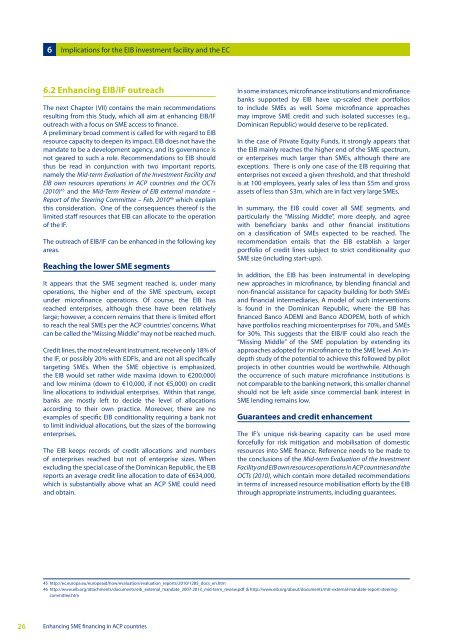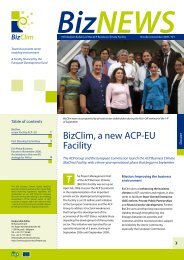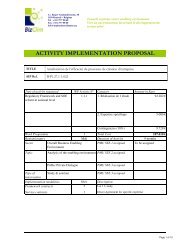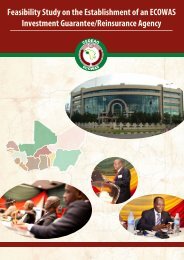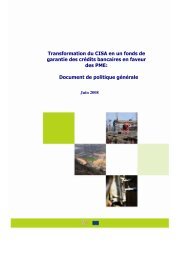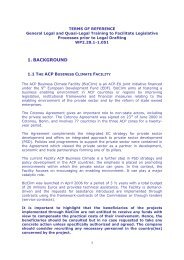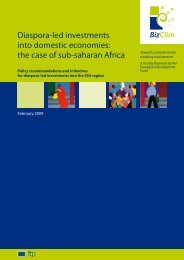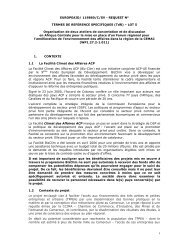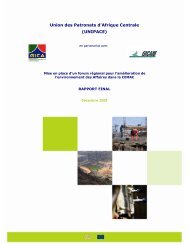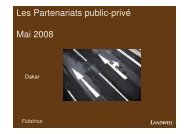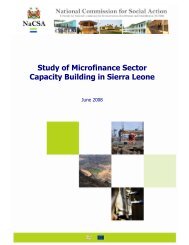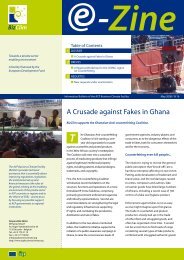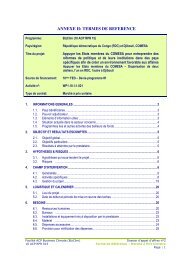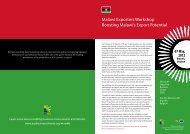Enhancing smE financing in acp countries - ACP Business Climate
Enhancing smE financing in acp countries - ACP Business Climate
Enhancing smE financing in acp countries - ACP Business Climate
Create successful ePaper yourself
Turn your PDF publications into a flip-book with our unique Google optimized e-Paper software.
6<br />
Implications for the eib <strong>in</strong>vestment facility and the ec<br />
6.2 <strong>Enhanc<strong>in</strong>g</strong> EIB/IF outreach<br />
The next Chapter (VII) conta<strong>in</strong>s the ma<strong>in</strong> recommendations<br />
result<strong>in</strong>g from this Study, which all aim at enhanc<strong>in</strong>g EIB/IF<br />
outreach with a focus on SME access to f<strong>in</strong>ance.<br />
A prelim<strong>in</strong>ary broad comment is called for with regard to EIB<br />
resource capacity to deepen its impact. EIB does not have the<br />
mandate to be a development agency, and its governance is<br />
not geared to such a role. Recommendations to EIB should<br />
thus be read <strong>in</strong> conjunction with two important reports,<br />
namely the Mid-term Evaluation of the Investment Facility and<br />
EIB own resources operations <strong>in</strong> <strong>ACP</strong> <strong>countries</strong> and the OCTs<br />
(2010) 45 and the Mid‐Term Review of EIB external mandate –<br />
Report of the Steer<strong>in</strong>g Committee – Feb. 2010 46 which expla<strong>in</strong><br />
this consideration. One of the consequences thereof is the<br />
limited staff resources that EIB can allocate to the operation<br />
of the IF.<br />
The outreach of EIB/IF can be enhanced <strong>in</strong> the follow<strong>in</strong>g key<br />
areas.<br />
Reach<strong>in</strong>g the lower SME segments<br />
It appears that the SME segment reached is, under many<br />
operations, the higher end of the SME spectrum, except<br />
under microf<strong>in</strong>ance operations. Of course, the EIB has<br />
reached enterprises, although these have been relatively<br />
large; however, a concern rema<strong>in</strong>s that there is limited effort<br />
to reach the real SMEs per the <strong>ACP</strong> <strong>countries</strong>’ concerns. What<br />
can be called the “Miss<strong>in</strong>g Middle” may not be reached much.<br />
Credit l<strong>in</strong>es, the most relevant <strong>in</strong>strument, receive only 18% of<br />
the IF, or possibly 20% with EDFIs, and are not all specifically<br />
target<strong>in</strong>g SMEs. When the SME objective is emphasized,<br />
the EIB would set rather wide maxima (down to €200,000)<br />
and low m<strong>in</strong>ima (down to €10,000, if not €5,000) on credit<br />
l<strong>in</strong>e allocations to <strong>in</strong>dividual enterprises. With<strong>in</strong> that range,<br />
banks are mostly left to decide the level of allocations<br />
accord<strong>in</strong>g to their own practice. Moreover, there are no<br />
examples of specific EIB conditionality requir<strong>in</strong>g a bank not<br />
to limit <strong>in</strong>dividual allocations, but the sizes of the borrow<strong>in</strong>g<br />
enterprises.<br />
The EIB keeps records of credit allocations and numbers<br />
of enterprises reached but not of enterprise sizes. When<br />
exclud<strong>in</strong>g the special case of the Dom<strong>in</strong>ican Republic, the EIB<br />
reports an average credit l<strong>in</strong>e allocation to date of €634,000,<br />
which is substantially above what an <strong>ACP</strong> SME could need<br />
and obta<strong>in</strong>.<br />
In some <strong>in</strong>stances, microf<strong>in</strong>ance <strong>in</strong>stitutions and microf<strong>in</strong>ance<br />
banks supported by EIB have up-scaled their portfolios<br />
to <strong>in</strong>clude SMEs as well. Some microf<strong>in</strong>ance approaches<br />
may improve SME credit and such isolated successes (e.g.,<br />
Dom<strong>in</strong>ican Republic) would deserve to be replicated.<br />
In the case of Private Equity Funds, it strongly appears that<br />
the EIB ma<strong>in</strong>ly reaches the higher end of the SME spectrum,<br />
or enterprises much larger than SMEs, although there are<br />
exceptions. There is only one case of the EIB requir<strong>in</strong>g that<br />
enterprises not exceed a given threshold, and that threshold<br />
is at 100 employees, yearly sales of less than $5m and gross<br />
assets of less than $3m, which are <strong>in</strong> fact very large SMEs.<br />
In summary, the EIB could cover all SME segments, and<br />
particularly the “Miss<strong>in</strong>g Middle”, more deeply, and agree<br />
with beneficiary banks and other f<strong>in</strong>ancial <strong>in</strong>stitutions<br />
on a classification of SMEs expected to be reached. The<br />
recommendation entails that the EIB establish a larger<br />
portfolio of credit l<strong>in</strong>es subject to strict conditionality qua<br />
SME size (<strong>in</strong>clud<strong>in</strong>g start-ups).<br />
In addition, the EIB has been <strong>in</strong>strumental <strong>in</strong> develop<strong>in</strong>g<br />
new approaches <strong>in</strong> microf<strong>in</strong>ance, by blend<strong>in</strong>g f<strong>in</strong>ancial and<br />
non-f<strong>in</strong>ancial assistance for capacity build<strong>in</strong>g for both SMEs<br />
and f<strong>in</strong>ancial <strong>in</strong>termediaries. A model of such <strong>in</strong>terventions<br />
is found <strong>in</strong> the Dom<strong>in</strong>ican Republic, where the EIB has<br />
f<strong>in</strong>anced Banco ADEMI and Banco ADOPEM, both of which<br />
have portfolios reach<strong>in</strong>g microenterprises for 70%, and SMEs<br />
for 30%. This suggests that the EIB/IF could also reach the<br />
“Miss<strong>in</strong>g Middle” of the SME population by extend<strong>in</strong>g its<br />
approaches adopted for microf<strong>in</strong>ance to the SME level. An <strong>in</strong>depth<br />
study of the potential to achieve this followed by pilot<br />
projects <strong>in</strong> other <strong>countries</strong> would be worthwhile. Although<br />
the occurrence of such mature microf<strong>in</strong>ance <strong>in</strong>stitutions is<br />
not comparable to the bank<strong>in</strong>g network, this smaller channel<br />
should not be left aside s<strong>in</strong>ce commercial bank <strong>in</strong>terest <strong>in</strong><br />
SME lend<strong>in</strong>g rema<strong>in</strong>s low.<br />
Guarantees and credit enhancement<br />
The IF’s unique risk-bear<strong>in</strong>g capacity can be used more<br />
forcefully for risk mitigation and mobilisation of domestic<br />
resources <strong>in</strong>to SME f<strong>in</strong>ance. Reference needs to be made to<br />
the conclusions of the Mid-term Evaluation of the Investment<br />
Facility and EIB own resources operations <strong>in</strong> <strong>ACP</strong> <strong>countries</strong> and the<br />
OCTs (2010), which conta<strong>in</strong> more detailed recommendations<br />
<strong>in</strong> terms of <strong>in</strong>creased resource mobilisation efforts by the EIB<br />
through appropriate <strong>in</strong>struments, <strong>in</strong>clud<strong>in</strong>g guarantees.<br />
45 http://ec.europa.eu/europeaid/how/evaluation/evaluation_reports/2010/1285_docs_en.htm<br />
46 http://www.eib.org/attachments/documents/eib_external_mandate_2007-2013_mid-term_review.pdf & http://www.eib.org/about/documents/mtr-external-mandate-report-steer<strong>in</strong>gcommittee.htm<br />
26<br />
<strong>Enhanc<strong>in</strong>g</strong> SME <strong>f<strong>in</strong>anc<strong>in</strong>g</strong> <strong>in</strong> <strong>ACP</strong> <strong>countries</strong>


